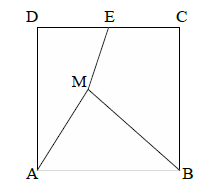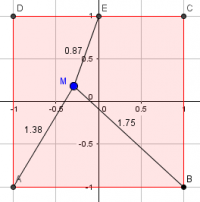Mahesh is lost (at point M) in a square forest ABCD.
His friends Abhay, Brijesh and Elena are respectively located at A, B and E, point E being the midpoint of side DC.
If the side of the forest is 2 km, what is the minimum value of the
sum of the distances between
Mahesh and his three friends?
Note: the figure shows approximate position of Mahesh.

His friends Abhay, Brijesh and Elena are respectively located at A, B and E, point E being the midpoint of side DC.
If the side of the forest is 2 km, what is the minimum value of the
sum of the distances between
Mahesh and his three friends?
Note: the figure shows approximate position of Mahesh.


